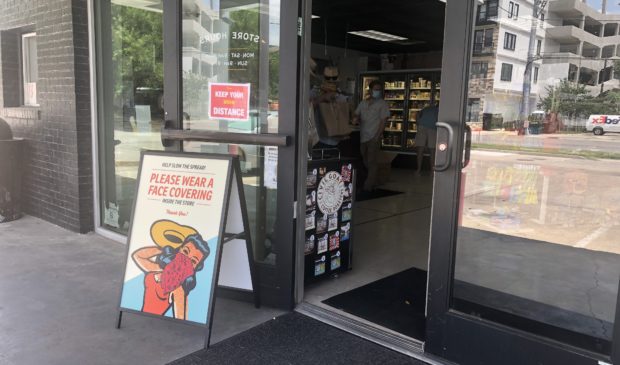City prepares ordinances to tap brakes on reopening and slow virus spread
Friday, July 10, 2020 by
Ryan Thornton City Council approved two ordinances Thursday intended to bring local businesses into compliance with regulations near to Phase 1 of Gov. Greg Abbott’s reopening plan.
“We can’t take the foot off the gas – we are not clear of this yet,” Mayor Steve Adler said at a special called meeting Thursday. “We are still in a pretty dangerous place.”
The ordinances lay out a set of social distancing rules, give the Austin Code Department authority to identify noncompliant locations as a public health nuisance, and allow the city public health authority to request legal action against offending sites. Noncompliant businesses may be subject to fines of up to $2,000, raised from $500 in the first draft of the ordinance.
In accordance with city health authority Dr. Mark Escott’s recommendations, the public nuisance ordinance guidelines are less restrictive than the governor’s shutdown of nonessential activities in April yet provide the protections Escott says are necessary to contain the virus spread.
The ordinance specifies that businesses are expected to ensure that all employees and patrons wear masks, disinfect common surfaces twice daily, limit gatherings to no more than 10 people with at least 6 feet between groups, and screen employees for virus symptoms at the start of each work shift. The regulations do not impact residential, child care, medical services, or government-owned sites.
The city reported a daily record of 753 new cases Wednesday, followed by 703 new cases Thursday, and has now reached an average of 75 daily new hospital admissions, passing a threshold that was previously associated with a Stage 5 (red level) local intervention barring all nonessential activities.
That threshold was based on total local hospital bed capacity – about 1,500 beds – but Dr. Lauren Ancel Meyers, the epidemiologist at the helm of the Covid-19 Modeling Consortium at UT Austin, told Council that further investigation has shown the primary limiting factor is actually total ICU capacity – between 331 and 474 beds depending on staffing resources. Meyers said the new metric essentially means the city has “less breathing room” than it had thought.
Although the rate of transmission has slowed 33 percent since mid-June, Meyers said it’s “likely at this point things will go up before they go down,” depending on how behaviors have shifted in recent weeks. Without slowing the transmission rate further, Meyers said the virus will be more prevalent in the community and will lead to new infection clusters among public school students the first day schools open on Aug. 18.
“We will probably still have a significant prevalence of the virus in Austin when it comes time to make decisions about schools,” Meyers said. “The more we do to slow transmission, up until Aug. 18, the more feasible it will be to open schools.”
Several residents called in to speak against the ordinances in public comment Thursday, many of them referring to social distancing and mask policies as government overreach. Gabe Coleman claimed the ordinances are motivated by politics, not safety: “This is a lie, it’s fake, it’s dumb. We need to stop it, we need to open things back up, keep them open. We need to get back to business.”
Escott said Council members and residents who are concerned about public health need only contrast such claims with readily available scientific data.
“None of us want this to be real, but it is,” Escott said. “None of us want to talk about dialing things down further because we know that hurts people also, we know that hurts our economy, we know that influences jobs. But we also know that if we don’t do something further, then we’re going to be placed in a situation that’s going to cost lives.”
The Austin Monitor’s work is made possible by donations from the community. Though our reporting covers donors from time to time, we are careful to keep business and editorial efforts separate while maintaining transparency. A complete list of donors is available here, and our code of ethics is explained here.
You're a community leader
And we’re honored you look to us for serious, in-depth news. You know a strong community needs local and dedicated watchdog reporting. We’re here for you and that won’t change. Now will you take the powerful next step and support our nonprofit news organization?




